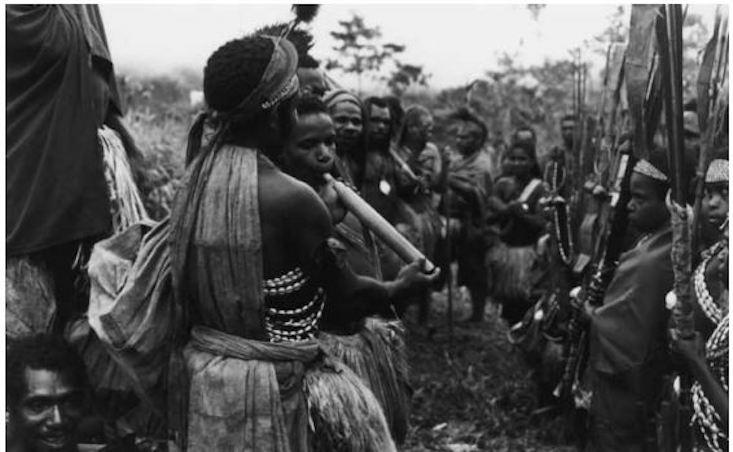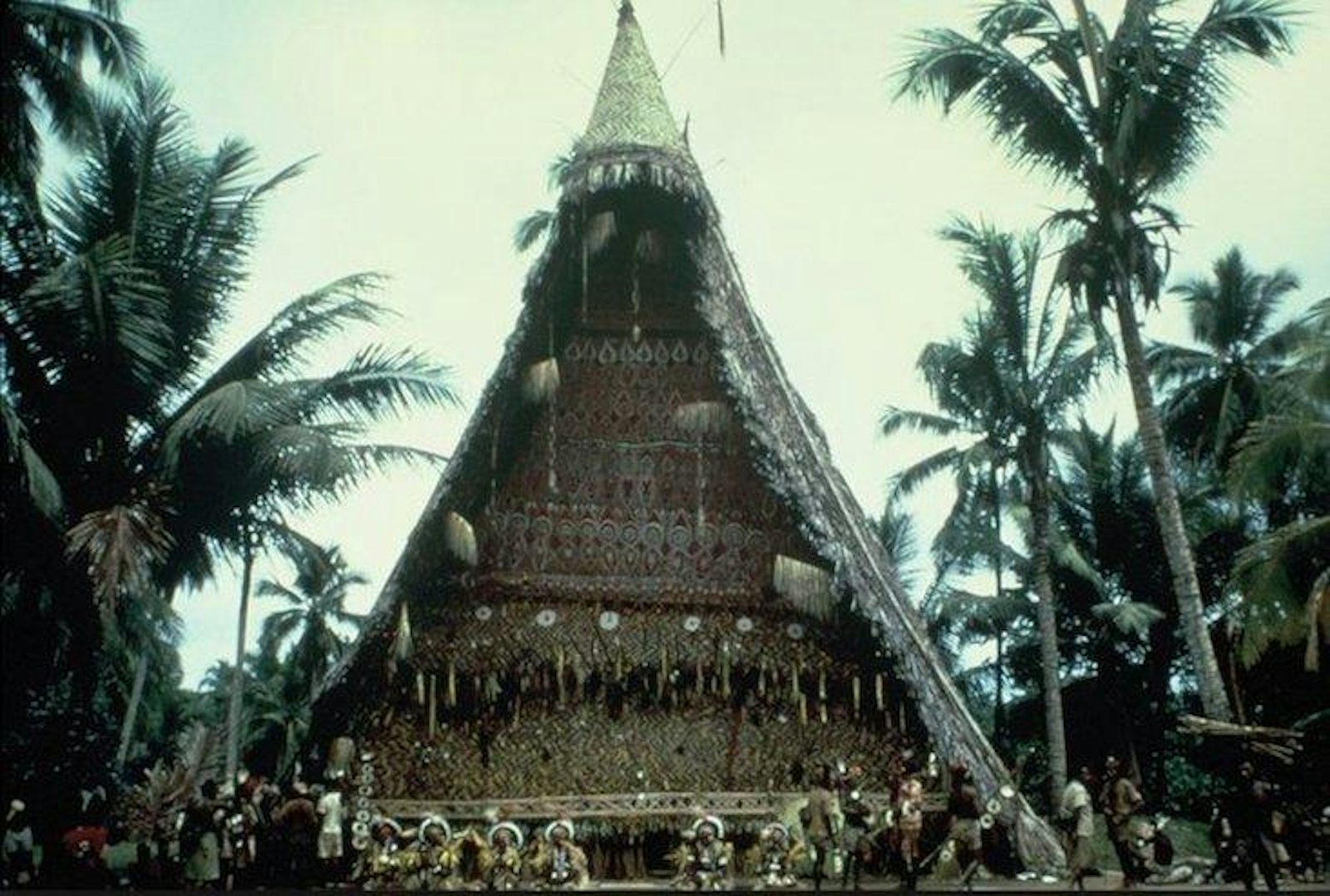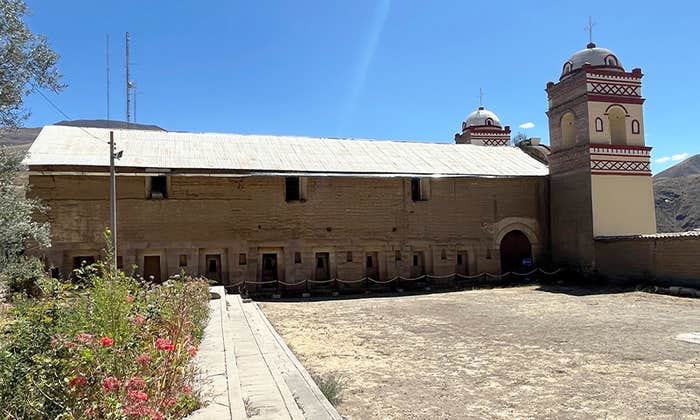One surprising thing about secret societies is how visible they are. In the ethnographic record, they can be found almost everywhere. They’re particularly well documented across Melanesia,1 the Amazon,2 and West Africa.3 There are mixed-sex,4 and all female,5 secret societies, but the ones that physically coerce, ritually deceive, and violently punish outsiders and taboo-violators are often entirely made up of males.6,7 These all-male secret societies are best described as “men’s cults,” because of their exclusionary nature and strong connection to male sex roles. They can be found among hunter-gatherer societies, horticulturalists, and agriculturalists alike, although many of those that have been described may no longer exist.8
The men’s cult is a conspiracy in plain sight. The “men’s house,” where the cult gathers, is often the largest structure in a village, built in a position of prestige at the center or top of a settlement. In villages across the Alaskan mainland and the islands of the Bering Strait, for example, the “kashim” (men’s house) was “the center of social and religious life,” wrote ethnologist Edward William Nelson.9 This is where most adult males and teenage initiates spend most of their time when not hunting or foraging. Among other things, it’s a ritual center for the men, where the cult’s sacred paraphernalia—often masks and/or musical instruments—is kept hidden from women and children.
The punishments for seeing them were severe. A woman who glanced at the sacred flutes among the Mundurucu of the Amazon, for example, would be gang-raped,10 and across New Guinea, a woman who saw the sacred objects was often executed.11 Male cult members whirl their bullroarers and play their flutes in private, hidden away from the women and children, who are told that these sounds are the voices of their ancestors. “Masking cults acted…as an agency of social control over women, children, slaves and foreigners…,” wrote historian Elizabeth Isichei, in A History of African Societies to 1870.12 Women in Ekpe societies in Nigeria, which had special masks of various colors, were, “on pain of death…not allowed to see the black masks,” noted anthropologist H.P. Fitzgerald Marriott.13 “These societies maintained secret knowledge, songs, and dances that gave them the power to emulate evil spirits, devils, and demons in rituals,” wrote anthropologist Ben Fitzhugh, in describing secret societies across Alaska. “It is widely reported that the performances of these secret societies were designed to invoke fear in women and children.”

Having that power would often come at a price. Young boys could view their initiation into the cult with a mixture of excitement and dread, since they’d be required to undertake a variety of dysphoric, or otherwise tortuous, rituals. All Aboriginal societies in the western desert of Australia practiced subincision, for example. The underside of a young boy’s penis would be slit, exposing the urethra, which does not heal closed. In anthropologist Robert Tonkinson’s study of Mardu hunter-gatherers, he wrote that subincisions were “badges of full manhood and proof of their right to participate in the sacred life.” Other common initiation practices among male cults include ritual seclusion, piercings, beatings, and inducing nose and penile bleeding.
The men’s cult is a conspiracy in plain sight.
Among some societies, such as the Sambia (a pseudonym) of New Guinea, initiation rites take on an explicitly sexual character. Boys begin living in the men’s house at about seven to 10 years of age. On the third day of their initiation, after rites involving beatings, nose bleeds, and stinging nettles, the young boys are introduced to the sacred flutes. The boys are lined up in a row, while a married man walks past them, placing a small bamboo flute up to each of their lips. The boys are then threatened and intimidated into sucking the flute, which is used for “teaching about the mechanics of homosexual fellatio,” wrote anthropologist Gilbert Herdt. An elder tells them, “Suppose you do not drink semen, you will not be able to climb trees to hunt possum; you will not be able to scale the top of the pandanus trees to gather nuts. You must drink semen…it can ‘strengthen’ your bones.” They are threatened with death if they should reveal the secrets of the cult.

There is a strong cross-cultural association of warfare with dysphoric and traumatic male rituals,14 which are a recurrent component of the men’s cults. The Sambian men’s cult has some clear parallels to the warrior society of ancient Sparta, for example, where boys were also separated from their mothers at the age of seven to live in the men’s house or camp and undergo dysphoric rites and rituals, including sexual relationships with older males.15
What was the point of men’s cults? Across a wide variety of mammalian species, including humans, males have a relatively common tendency to seek to monopolize access to resources—food, territory, females, knowledge—that can increase their reproductive success.16,17,18,19 The presence of warfare and marriage exchanges with enemies offer some plausible functional explanations. The secret rituals and rites may help socialize young boys into becoming effective warriors, and marriage exchanges with enemy or neighboring groups could be useful to avoid incest and forge alliances, and may help explain some of the institutionalized distrust and enmity in these societies between men and women,20 who men often consider to be contaminated or polluting. “Men’s secular rhetoric and ritual practices depict women as dangerous and polluting inferiors whom men are to distrust throughout their lives,” Herdt wrote of the Sambia. Of societies in Alaska, Nelson wrote, “During menstruation women are considered unclean and hunters must avoid them or become unable to secure game.” This may be an example of social norms tapping into, and repurposing, human’s natural disgust reaction.21
Men’s cults also seem to allow older males to control the sexuality of young males, reducing reproductive competition and increasing their own paternal certainty. As is common among mammalian males, men develop strategies to increase the likelihood that the children of the women they mate with are their own. Of the Ilahita Arapesh, anthropologist Donald Tuzin wrote, “…there was a specific taboo, strong and apparently effective, against premarital sexual contact. This injunction was much stronger for males than for females…”22 The Ache hunter-gatherers of Paraguay don’t have a men’s cult; however, their social organization does exhibit some similarities in this regard. Boys are forbidden from engaging in sexual activity until they’ve undergone initiation rites conducted by older males, such as a lip piercing and mock club-fights.23 Across many aboriginal Australian societies, young males are kept from marrying, while elder males were able to have multiple young wives.24
The fact that men’s cults can be found across so many diverse small-scale societies may point to a deep historical origin. Archaeologists Oliver Dietrich and Jens Notroff have speculated that Göbekli Tepe, a site in Turkey around 12,000 years old, may represent a sanctuary for a men’s cult. Anthropologists D’Ann Owens and Brain Hayden speculate that secret societies (not necessarily men’s cults) may go back to the Upper Paleolithic, and argue that caves during the Upper Paleolithic were used to initiate elite children into secret societies.25 In The Nature of Paleolithic Art, R. Dale Guthrie argued that adolescent boys made most Upper Paleolithic cave art.26 Paleolithic art often consisted of hunting scenes, naked women, and phallic imagery, which seems consistent with the notion—difficult to test—that they were made as part of an initiation into a men’s cult.
Men’s cults are not universal, but they recur throughout history and across cultures. This pervasiveness tells us something important about evolution and human behavior: When important resources—whether wealth, access to mates, or even knowledge—can be forcefully monopolized, men seem more likely to form the type of aggressive and domineering coalitions exhibited by the men’s cults. Understanding them is key as people continue to develop and maintain more inclusive political and social institutions characterized by the rule of law and norms discouraging of violence and authoritarianism.
William Buckner is a student of Evolutionary Anthropology at UC Davis. He is interested in cultural evolution and understanding human conflict patterns across cultures. He can be followed on Twitter @Evolving_Moloch. This post was reprinted with permission from Buckner’s blog, Traditions of Conflict.
Lead image from The Cassowary’s Revenge (1997) by Donald Tuzin
References
1. Herdt, G. 2003. Secrecy and Cultural Reality: Utopian Ideologies of the New Guinea Men’s House. Ann Arbor: University of Michigan Press.
2. Murphy, R. F. 1959. Social structure and sex antagonism. Southwestern Journal of Anthropology
3. Butt-Thompson, F.W. 1929. West African Secret Societies. High Holborn London: H. F. & G. Witherby.
4. Elmendorf, W.W. 1948. The Cultural Setting of the Twana Secret Society. American Anthropologist.
5. Bosire, O.T. 2012. The Bondo secret society: female circumcision and the Sierra Leonean state PhD Thesis: University of Glasgow
6. Herdt, G. 1982 Rituals of Manhood: Male Initiation in Papua New Guinea. Berkeley: University of California Press.
7. Webster, H. 1908. Primitive Secret Societies. New York: The Macmillan Company.
8. There is certainly significant variation across these societies, however the description that follows here is consistent with the record of numerous men’s cults across Melanesia and the Amazon, in particular.
9. Nelson, E.W. 1900. The Eskimo about Bering Strait. Extracts From the Eighteenth Annual Report of the Bureau of American Ethnology. Washington: Government Printing Office
10. Murphy, Y. & Murphy, R. 1985. Women of the Forest. New York: Columbia University Press.
11. Hays, T.E. 1986. Sacred Flutes, Fertility, and Growth in the Papua New Guinea Highlands. Anthropos
12. Isichei, E. 1997. A History of African Societies to 1870. United Kingdom: Cambridge University Press
13. Fitzgerald Marriott, H.P. 1899. The Secret Societies of West Africa. The Journal of the Anthropological Institute of Great Britain and Ireland
14. Sosis, R. et al. 2007 Scars for war: evaluating alternative signaling explanations for cross-cultural variance in ritual costs. Evolution and Human Behavior
15. Herdt, G. 2006. The Sambia: Ritual, Sexuality, and Change in Papua New Guinea. Belmont: Wadsworth publishing.
16. Jaeggi, A.V. et al. 2016. Obstacles and catalysts of cooperation in humans, bonobos, and chimpanzees: behavioural reaction norms can help explain variation in sex roles, inequality, war and peace. Behaviour
17. Nettle, D. & Pollet, T.V. 2008. Natural Selection on Male Wealth in Humans. The American Naturalist
18. Betzig, L. 2012. Means, variances, and ranges in reproductive success: comparative evidence. Evolution and Human Behavior
19. Glowacki, L. et al. 2017. The evolutionary anthropology of war. Journal of Economic Behavior & Organization
20. Ember, C. 1978. Men’s fear of sex with women: A cross-cultural study. Sex Roles
21. Curtis, V. et al. 2011. Disgust as an adaptive system for disease avoidance behavior. Philosophical Transactions of the Royal Society B
22. Tuzin, D. 1997. The Cassowary’s Revenge. Chicago: University of Chicago Press.
23. Hurtado, A.M., & Hill, K., 1996. Ache Life History: The Ecology and Demography of Foraging People. New York. Routledge
24. Bodley, J.H. 1994, 2017. Cultural Anthropology: Tribes, States, and the Global System. Lenham: Rowman & Littlefield.
25. Owens, D. & Hayden, B. 1997. Prehistoric Rites of Passage: A Comparative Study of Transegalitarian Hunter – Gatherers. Journal of Anthropological Archaeology
26. Guthrie, R.D. 2005. The Nature of Paleolithic Art. Chicago: University of Chicago Press.






























